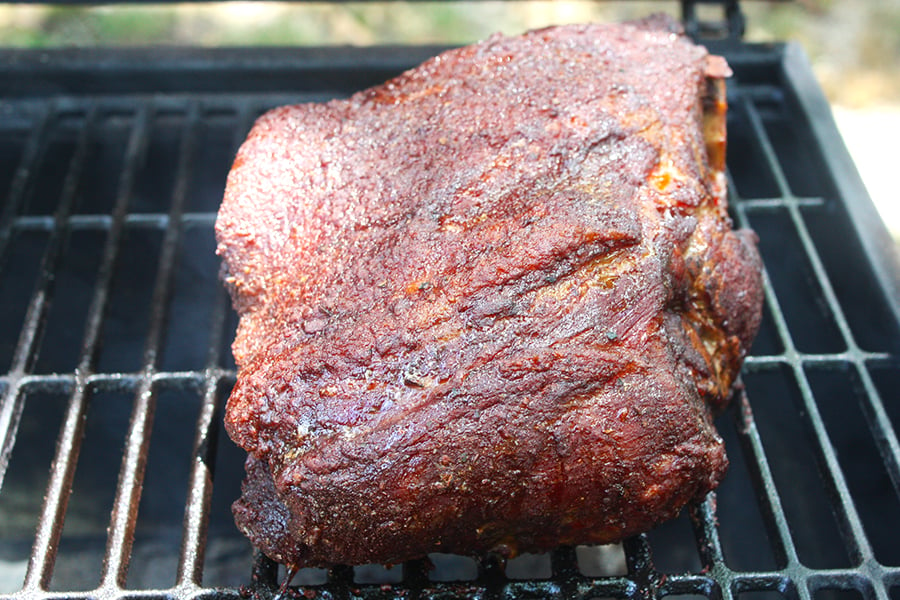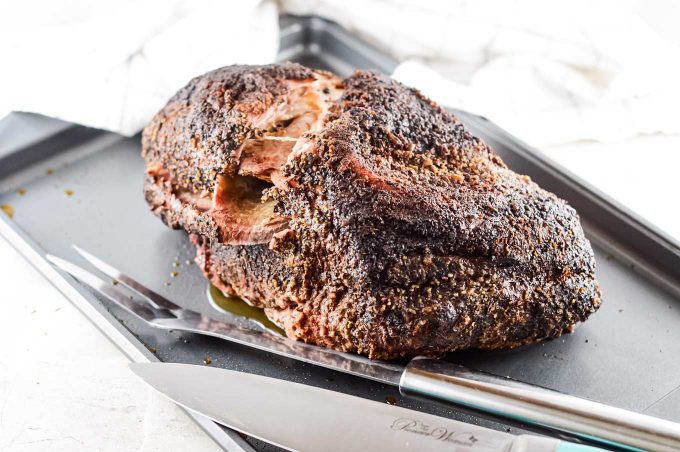This Pork Shoulder is smoked low and slow, which makes the most delicious, tender pulled pork that melts in your mouth. It’s perfect for any cookout or BBQ, and it comes with grill cooking instructions as well.
This Smoked Pork Shoulder recipe is one of those that I love to make for potlucks and bbq’s. We also love easy smoker recipes like my Smoked Chicken Wings and 3-2-1 Smoked Ribs. This is one of my Summer recipes I know you’ll want to keep on hand!.
I love barbecue more than any other summer food. I love smoked meats of all kinds, in any flavor. Just gimme that smoke ring!!.
Even though my husband smokes more than anyone else in our house, I like to join in every once in a while—it’s fun!
Smoked pork shoulder is a great crowd-pleaser, and it makes a TON. There is enough pork shreds for sandwiches, potato and mac and cheese toppings, and more to freeze after you’re done.
There’s something about that succulent meat combined with the peppery bark-like crust that just makes me SO hungry. Now you don’t have to pay a fortune for a small piece of pork shoulder at a barbecue joint—you can make your own smoked pork shoulder at home!
Smoked pork shoulder also known as smoked pork butt is a delicious cut of meat that’s full of flavor. When smoked low and slow, the pork shoulder becomes incredibly tender and juicy. But knowing the right temperature to smoke a pork shoulder is key to getting the best results. In this article, we’ll walk through everything you need to know about picking the ideal temperature and cook time for smoking pork shoulder.
Why Temperature Matters for Smoked Pork Shoulder
Temperature is one of the most important factors when smoking pork shoulder. Cooking the pork at the proper temperature ensures:
-
The meat cooks evenly all the way through.
-
The fat renders and connectsive tissue breaks down for tenderness
-
You get that quintessential smoky barbecue flavor.
-
The pork shoulder doesn’t dry out from overcooking.
Maintaining the right temperature range when smoking pork shoulder keeps the meat moist while allowing enough time for the tough connective tissues to transform into succulent, pull-apart meat.
Choosing the Best Temperature for Smoked Pork Shoulder
When smoking pork shoulder, a temperature range of 225°F to 250°F is ideal. This low and slow cooking method allows the pork shoulder to smoke for an extended period of time. The temperature is hot enough to cook the meat and melt the fat, but not so hot that the pork dries out.
Here’s a more in-depth look at why this temperature range works well:
225°F to 250°F – This relatively low temperature range cooks the pork shoulder evenly from the outside in. The meat has plenty of time to absorb smoke flavor. The fat and connective tissues break down over several hours, resulting in incredibly moist, fall-apart meat.
Higher than 250°F – Temperatures exceeding 250°F begin to cook the pork shoulder more rapidly. This can lead to dried out meat, since the tissues and fat don’t have time to fully break down and baste the meat. The pork also won’t pick up as much smoky taste at higher temps.
Lower than 225°F – Dropping below 225°F slows down the cooking process too much. While the meat remains moist, it takes much longer for the connective tissues to melt into tender meat. Unless you don’t mind extremely lengthy smoke times, 225°F is the lowest temperature I would recommend.
Sticking with 225-250°F as you smoke pork shoulder gives you that perfect low and slow cooking method barbecue is renowned for. Now let’s look at determining cook times…
Estimating Cook Time for Smoked Pork Shoulder
The total cook time for smoked pork shoulder depends on a few factors:
-
The size and shape of the pork shoulder – Larger and thicker cuts of meat will clearly take longer to smoke than smaller shoulders.
-
The actual temperature you smoke at – Pork cooked at 250°F will finish faster than if you smoke it at 225°F.
-
If you cook bone-in or boneless – Boneless shoulders often cook a little more quickly.
-
If you foil wrap -Wrapping the pork shoulder in foil or butcher paper partway through traps heat and moisture and accelerates cooking.
Because cook time varies quite a bit, it’s best to use a meat thermometer and focus on the internal temperature rather than total time spent smoking.
Here are some general time estimates based on typical pork shoulder sizes:
-
5-7 lb shoulder – Allow 1 1/2 to 2 hours smoked per pound at 225-250°F. This usually means a total time of 7 to 14 hours.
-
8-10 lb shoulder – Estimate 1 to 1 1/2 hours per pound. Total cook time ranges from 10 to 18 hours.
-
10-12 lb shoulder – Figure around 1 hour per pound, for a total smoke time of 12 to 18 hours.
The most accurate way to tell when the pork shoulder is done…use a meat thermometer!
Use a Thermometer for Perfectly Smoked Pork
Rather than try to predict smoked pork shoulder cook times exactly, I highly recommend using a good digital meat thermometer. Insert the thermometer probe into the thickest part of the pork shoulder, then monitor the temperature as it smokes.
The ideal finished temperature for smoked pork shoulder is 203°F. At this point, the pork will be fall-apart tender and ready to pull or shred.
Here are some other important internal temperature stages as the pork shoulder cooks:
-
160-165°F – The collagen begins breaking down into gelatin.
-
175°F – The pork shoulder starts becoming very tender.
-
185°F – The fat has fully rendered and the meat is succulent.
-
203°F – The pork is completely tender and ready to eat!
Smoking a pork shoulder is done when it reaches 203° internally in the thickest part of the meat. The shoulder will look extremely tender and you should be able to twist a fork in the meat with little resistance. Use your thermometer to monitor the temperature and avoid under or overcooking.
Tips for Maintaining Temperature While Smoking
Here are some tips for keeping your smoker at the ideal 225-250°F temperature range for the many hours required to smoke pork shoulder:
-
Use a water pan – Adding a water pan or spraying the shoulder helps regulate temps.
-
Leave the lid closed – Resist opening the smoker, which causes heat loss.
-
Preheat the smoker – Let it heat up to 225-250° before adding the pork.
-
Add extra charcoal – For charcoal smokers, add more coals as needed to maintain heat.
-
Use a thermometer – Keep an oven-safe thermometer inside to monitor the temp.
-
Adjust the vents – Control air flow to raise or lower the temperature.
-
Use a smoker with good insulation – Well-insulated smokers hold heat extremely well over time.
Controlling the temperature is easy with some practice. The most foolproof method is using a good digital thermometer to see the internal temp of the pork as it smokes low and slow.
Injecting and Foil Wrapping Smoked Pork Shoulder
Two popular methods that speed up cook times for smoked pork shoulder are injecting and foil wrapping. Here’s a look at each:
Injecting – Injecting flavors directly into the pork shoulder helps season it from the inside out. Common injections include apple juice, beef broth, Worcestershire sauce and rub flavors. While injecting doesn’t affect temperature per se, it does shorten cook times slightly since the pork cooks from the inside and out. Be sure to inject flavorings the day before smoking.
Foil Wrapping – Known as the “Texas crutch”, wrapping the pork shoulder in foil or butcher paper partway through retains moisture and heat. Many competition barbecue cooks will wrap pork once it hits an internal temp around 165°F. The trapped heat gives the pork a little oven-like effect, allowing it to reach 203°F faster. Just be sure to finish unwrapped to add flavor.
Both injecting and foil wrapping are optional but can reduce total cook times by several hours. Use them if you want the pork ready faster.
Master Smoking Times Based on Pork Shoulder Size
To recap, the ideal temperature for smoked pork shoulder is 225-250°F. Use these smoking time estimates as a starting point based on pork shoulder size:
- 5-7 lbs = about 1 1/2 hours per lb (total of 7-14 hours)
- 8-10 lbs = about 1 hour per lb (total of 10-18 hours)
- 10-12 lbs = around 1 hour per lb (total of 12-18 hours)
The absolute best way to know when pork shoulder is done is to use an accurate meat thermometer. Remove the pork once it reaches an internal temperature of 203°F.
Refer back to this guide whenever you smoke pork shoulder and you’ll have perfectly cooked, mouthwateringly tender barbecue every time. Have fun experimenting with different rubs, wood smoke flavors and finishing sauces – just be sure to nail those ideal smoking temperatures. Enjoy your amazing homemade smoked pork shoulder!

COOK TO TEMPERATURE, NOT BY TIME
When smoking, you need to use the cook time, as a guideline, not an actual timer. There are a lot of things that can cause a piece of meat to take longer to smoke, like the meat itself, changes in the smoker, wind and temperature outside, and more.
The key to smoking is going low and slow and with plenty of patience. Instead of relying on time, you’ll want an internal thermometer. The internal temperature of the meat is what you’ll be using instead of time.
Here are some links to my favorites. But don’t think you have to spend a lot of money to get them. You can get a quality thermometer for not much more than a large pizza!.

VARIATIONS OF THIS RECIPE
- MESSAGE: In this recipe, I used olive oil to hold the rub to the pork shoulder. But I’ve also made it with plain yellow mustard, like I do with my Crockpot Beef BBQ. It works just as well and gives the food a little tang.
- BEER – Beer and pork go really well together. Try adding some bourbon to the spray bottle and/or the baking dish of water.
- BBQ SAUCE: This pork is so flavorful that you might not even need or want barbecue sauce. But if you do, use your favorite store-bought sauce or try my Bourbon BBQ Sauce or Dr. Pepper BBQ Sauce.
- LOW CARB: If you’re very careful about how many carbs you eat, you could use a sugar substitute like Swerve instead of the brown sugar. Also, make sure you’re using apple juice that has not been sweetened.
What Temperature Should I Cook My Pork Butt At
FAQ
What temperature is smoked pork shoulder done?
Should pulled pork be 190 or 200?
Is it better to smoke pork shoulder at 225 or 250?
Is a pork shoulder done at 180?
